Ensuring a Safe Off-Grid Water Supply
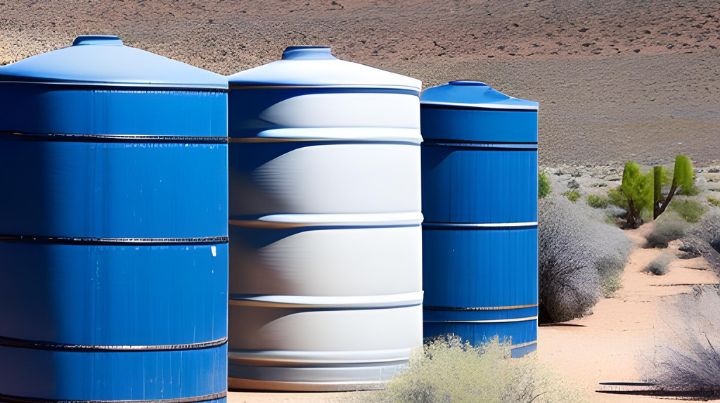
Lyle, a Mind4Survival reader, sent me this question:
“I just purchased an off-grid cabin in Northern Arizona that hasn’t been lived in for five years or more. A local company hauls water to this and other parcels, and we have two empty containers for water, one of about 400 gallons and the other of about 500 gallons. Plus, I have two 55-gallon water barrels—one empty and one full. We also have about 20 store-bought one-gallon never opened containers. I’m unsure of how to deal with full containers stored this long or the two great big ones. Your advice would be greatly appreciated.”
Congratulations!
First, congratulations on your off-grid cabin in northern Arizona! You’re living the prepper dream and diving right into one of the most important aspects of survival, fulfilling your off-grid water supply needs.
You’re taking the correct course of action—ensuring you have a safe water supply. As preparedness-minded people, we know that providing a safe and reliable water supply is crucial for any off-grid dwelling. That becomes even more essential when living in an arid area such as Northern Arizona.
Use a Phased Approach
Given your situation and the fact that the water may have been sitting for five years, the best course of action may be to follow a phased approach. This will allow you to prioritize your tasks and gradually work towards achieving your goals while also conserving one of your most precious resources—water.
On that point, your most challenging time in all of this is at the beginning. This is because you don’t know the status of any water currently stored in the containers. It could have been there for years. Additionally, you don’t know if there are any contaminants in the water from the previous owner. Therefore, you’re starting from scratch, meaning you have no clean water, to begin with—at least no water that you know is clean. As for the 20 store-bought one-gallon never opened containers, if they’ve been sitting there for years, I’d consider them non-potable and possibly contaminated as well.
On that point, as water is a precious commodity for you, if there are things you need to do that don’t require potable water, I’d consider using what you have for those tasks. However, erring on the side of caution, I’d be hesitant to use it for anything to do with hygiene, cooking, washing clothes, etc.
Daily Water Consumption Needs
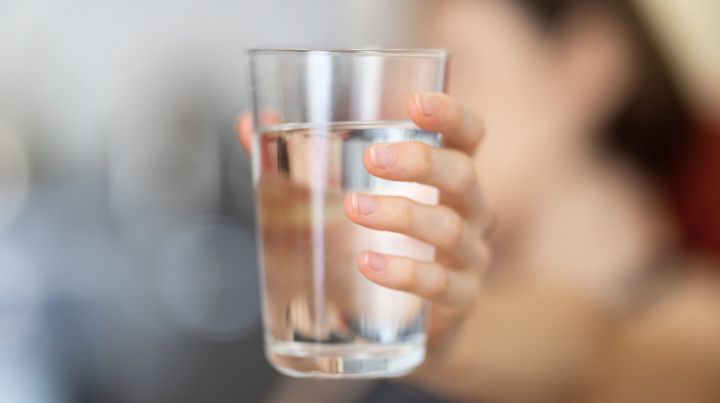
Next, since water is such a precious resource for you, I’d make sure to stay on top of your daily water consumption needs and project that over the long term. Always keep track of how much potable water you have on hand and how much you use. That way, you’ll always know how many days, weeks, and months of water you have available.
With that, I wrote this article and did a podcast on “Calculating Your Daily Water Consumption Needs” in response to another listener’s question. Ultimately though, a conservative estimate for daily water needs is around one gallon per person for drinking and cooking purposes. However, when you add in water consumption for hygiene, dishwashing, and other activities, you will find your daily water usage at 2-3 gallons or more per person. Remember that it doesn’t consider water for crops, animals, etc.
The good news is that when your water storage is cleaned, sanitized, and full, you’ll have about 1100 gallons of water storage available. That’s 13 months of water for one person using three gallons per day or approximately six months for two people. That’s a great start.
In the end, keeping meticulous notes about your water usage on a daily basis will, over time, provide you with an excellent historical record that’s specific to your situation. Moreover, that will aid you with predicting your usage throughout the year as seasons and your needs ebb and flow.
Phase 1: Take Care of Your Immediate Water Needs
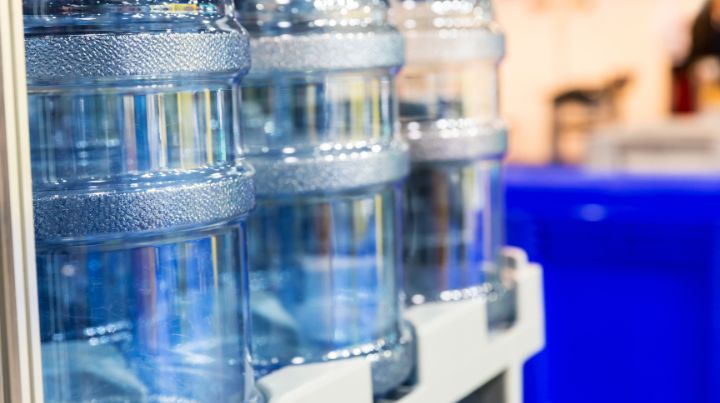
Now, back to your situation. Your immediate need is to ensure that you have potable drinking water on hand to get by while you empty, sanitize, and refill your other containers. Therefore, you will have to make arrangements to supply yourself with safe drinking water until you can get the other containers prepped and filled when the delivery truck shows up.
To make it until then, I’d suggest looking in town for some refillable three to five-gallon water bottles. As there are a lot of people in similar circumstances in the region, many towns and supermarkets in the Southwest have pay-as-you-go filtered water stations where you can fill up. How many of those you get depends upon your budget, water needs, and transportation options.
Phase 2: 55-Gallon Water Drums
With your water needs met for the short term, I’d next focus on the two 55-gallon water drums. Of your four large-volume containers, the 55-gallon drums will be the easiest to empty, sanitize, and refill. Together, the two give you 110 gallons, which at three gallons per day, is 36 days’ worth of water for one adult or 18 days for two adults.
Empty the Barrel
Next, I’d empty the full 55-gallon water barrel using a simple siphoning technique. Begin by placing one end of a hose or tube (preferably food grade) into the full barrel, ensuring it reaches the bottom. Place the other end of the hose in an empty container (if you’re saving the water) or at a point lower than the barrel. Then by creating suction or using gravity, get the water flowing from the barrel until it’s empty.
An easier, more controlled method for draining the barrel will be to use this $38 55-gallon drum pump from Amazon. They work well and allow you to quickly get water from your barrels in a controlled, non-wasteful manner.
Warning: Don’t drain the barrel by pushing it onto its side. While water barrels are relatively tough, they do crack, and you run the risk of making them unusable.
Clean and Sanitize the Containers
Now that you have the barrels empty, it’s time to clean and sanitize them. I’d clean them using a pressure washer. As you’re tight on water, and if you have the means, I’d consider transporting them to a self-car wash in town. Once there, you can pressure rinse the inside of the barrels.
Pressure Rinsing Process:
- Start by running the spray nozzle long enough so that all the soap is cleaned out of the line.
- Insert the nozzle into each barrel and pressure rinse the inside.
- Once you’ve thoroughly rinsed them, gently turn the barrels on their side, and drain the water out.
- Rinse and repeat this until the water comes out clean.
With the insides free of residue, it’s time to sanitize the barrels. This is one method of sanitizing the inside, and I recommend researching to determine what works best for your specific needs.
Sanitizing Process: (Here’s a Mind4Suirvival article on sanitizing water containers)
- Create a sanitizing solution by mixing one teaspoon of unscented household bleach per gallon of water.
- Use this solution to wash the containers, ensuring all surfaces come into contact with the solution. (With your water drums, you can do this by rolling the barrel on its side to slosh the water around so it contacts all interior surfaces.)
- Let the containers sit for at least 30 seconds but no more than 5 minutes.
- Rinse the containers thoroughly with clean water to remove any traces of bleach.
- Allow the containers to air dry in a clean and shaded area.
Once the barrels are cleaned and sanitized, they’re ready to be filled the next time your water delivery stops by.
Phase 3: 400 & 500 Gallon Water Tanks
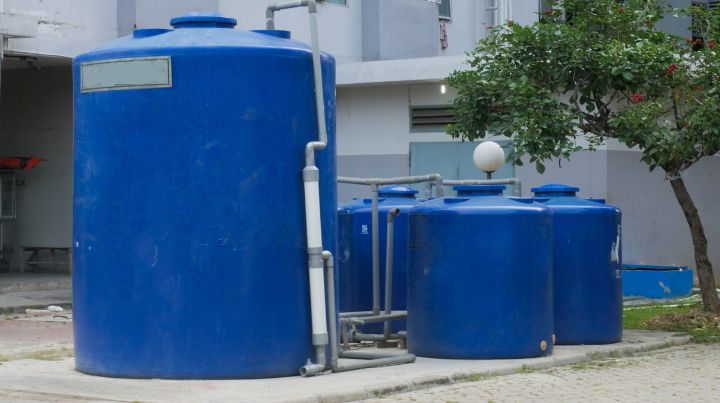
Now that your 110 gallons of water is on hand and ready to meet your medium-term water needs, it’s time to take care of your 400 and 500-gallon water tanks.
Again, I’d start by draining one or the other, then rinsing and sanitizing it in a process similar to what you used for the 55-gallon drums. If these large tanks are too big and cumbersome to drive into town, I’d consider renting a pressure washer for the day and taking care of them onsite. The process should be pretty straightforward. Then, once they’re set, fill them up, and you should be set to go.
Water Conservation
As someone who has spent a fair amount of time lugging my water in three-gallon water cubes a few hundred yards from a spigot to my trailer in the woods, I found that water conservation becomes a habit. For example, I enjoyed washing my dishes with as little water as possible—usually under eight ounces for a couple of days’ worth of dishes.
With that, when time and resources permit, I’d do my best to set up a rain catchment system to gather as much of the little rainfall that you have as possible. Also, as I mentioned earlier, doing your best to monitor your usage throughout the year will make you intimately familiar with how much you’ll need and when—and that’s not only called planning, that’s called preparedness.
The Bottom Line on Ensuring a Safe Off-Grid Water Supply
Going off your question, I feel using this, or a similar phased approach, allows you to address immediate water needs while working towards a long-term solution for ensuring a safe and reliable water supply at your off-grid cabin. In the end, remember to be mindful of water conservation measures to maximize your limited water supply.
Thanks for your question, and I hope that helps!
If anyone else has any comments to help Lyle and others in similar circumstances, please post them in the comments below.
Additional Resources:
- Sanitizing Water Containers: Here’s How to Do It
- Easy DIY Water Storage for Frugal Preppers
- How Long Does Stored Water Last? It Depends
- Long-Term Water Storage for Emergencies
Stay safe,

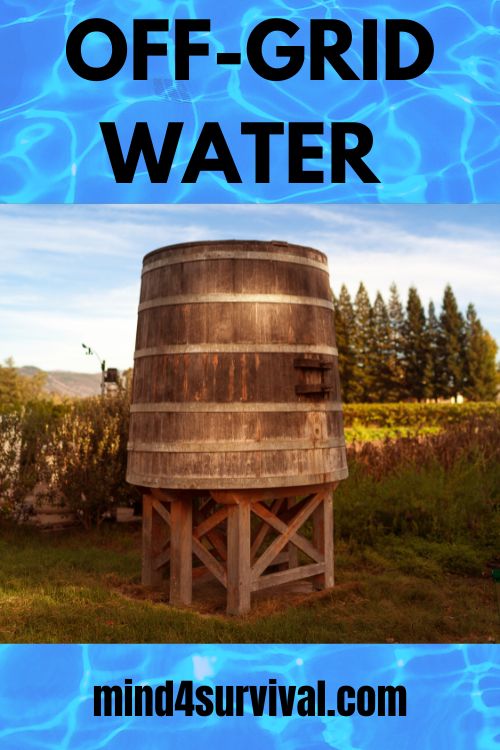
Don't Miss Out!
Join the thousands of people who rely on Mind4Survival preparedness advice by subscribing to our FREE newsletter.
- Practical preparedness information
- Zero Spam
- < 0.25% of people unsubscribe




Join Mind4Survival!
Stay informed by joining the Mind4Survival! 100% Secure! 0% Spam!
Follow Us!
Affiliate Disclosure
Mind4Survival is a free, reader-supported information resource. If you make a purchase through our link, we may, at no cost to you, receive an affiliate commission.


You could use the questionable water for cleaning, flushing the toilets, filling up the “p” traps in the drains, etc. If it has been empty for five years, you will want to check the integrety and condition of all the grey and black water pipe systems. don’t run it thru the clean water systems! Only use known potable water for that!
Hi Brian, Thanks for the good advice. Up until a generation ago most houses in Australia had a rainwater tank as a primary water supply. Corrugated iron and concrete has largely been replaced by roto mold plastic tanks. Now these tanks NEVER got cleaned out and strangely enough I have never heard of anyone getting sick. Granted, any gut parasites from bird droppings may have been naturalised as part of the bacteria community inside the human hosts. Today, in large towns, there is the pollution aspect to consider as rain washes everything clean off the roof but in the country areas where rainwater is still the main source of water it isn’t. Filtration is an added expense as carbon filter replacement is recommended every six months although we do clean the primary sediment filter and reuse to keep costs down. The other important thing I’ve found with filtered water is brewed coffee tastes so much better. So in summary, I agree that tanks need cleaning if you have concerns about the environment and it’s cleanliness (an inspection with a flashlight inside will be a good start) but remote locations should be ok and worth the small risk of drinking it raw. However the small amount of chlorine required to treat water is inexpensive and gives peace of mind.